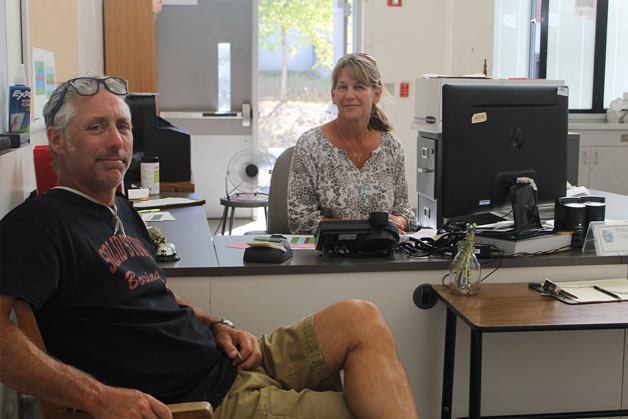Charlie Davies, case manager for South Whidbey Academy, won’t have an office for the 2016-17 school year. He doesn’t want one either.
His “desk” will be wherever students are.
Davies will be the lead teacher and advocate for academy students when they occupy their new home in the north wing of South Whidbey High School for the first time on Sept. 6. The newly formed position, which Davies described as being a hybrid counselor, will serve as a primary support system for students, emphasizing the achievement of goals and aspirations, Davies said. He’s more than qualified for the position, said South Whidbey School Principal John Patton, having worked for 27 years in both alternative and special education. For the past seven years, Davies was a special education case manager.
He also spent several years at the Northwest Regional Learning Center in Everett, a school for kids with extreme behavior issues and involvement in the juvenile justice system.
“I’ve always worked with kids who were kind of on the outside,” Davies said. “That’s always been my passion and what I like to do.”
In February, the South Whidbey School District announced it would be co-locating the alternative school’s 9-12 program. The move drew ire from parents and students during a February meeting, who criticized school leaders for a lack of communication and a chance for input in the decision-making process. A similar move was also made for the academy’s 6-8 program in June.
Skagit Valley College now occupies the area vacated by the 9-12 program, also known as “Building C.” After being moved from the north wing of the high school to make room for the academy after only one year, the newest transition should be more long-term, according to school district Superintendent Jo Moccia in an interview Wednesday.
The agreement became effective July 1 and will expire June 30, 2021. The college will pay the district $2,150 per month for 2,150 square feet of space, plus an additional $55 per month network fee.
Davies and Patton expect there to be hiccups with the academy’s new arrangement, so making sure parents and students know what’s going on will be vital, Davies said.
“The whole key to this thing is communication,” he said.
In the north wing of the school, the students will have autonomy from the rest of the student body, Davies said. The section contains two classrooms, a commons area formerly used as an arts studio and a courtyard with benches and a table. The commons area will be used as a place to eat lunch, hang out before school and conduct independent studies classes.
Some of the perks, said Davies, is student access to the high school’s career and technology classes, career counseling staff, graduation plans and Island County Mental Health counselors, as well as extra-curricular activities such as athletics and clubs.
Academy students used to commute between the elementary school and high school for certain classes. With the students now in-house, it will be readily available for them, Davies said.
“The academy doesn’t have enough opportunities to meet every one of their electives, so there’s going to be some sharing, which was going on already,” Davies said.
The students will retain teachers like Leah Tormey from the academy while faculty from the high school, such as math teacher Andy Davis, will also instruct some classes. Their curriculum will remain the same, Davies said. Patton said student learning styles will dictate how classes are taught.
“Every kid has a different learning style, so we need to approach those different learning styles with what they call ‘differentiated instruction,’ which is basically just different ways of teaching the same subject area,” Patton said.
“One size doesn’t fit all,” Davies added.
Davies and administrative assistant Christine Amundson have worked hard to make it a seamless transition come Sept. 6, as the duo was busy cleaning and organizing the academy’s space all summer. First, they cleared out old art supplies, trash and other assorted items from every nook and cranny in the former arts studio. In early July, they organized various items that were brought over from the 9-12 former space at the elementary school, and added a front reception desk. For some added flare, Davies hung up artwork by academy students from previous school years on the walls around the commons.
The idea, he said, is for academy students to feel at home when they enter the commons area.
Davies and other administrators recently began fielding questions from parents and students for the upcoming school year.
“We want to connect and start the relationship that will be a journey for these kids,” Davies said.
His goal is for students to acknowledge and pursue their career and life goals with diligence, and to pick and choose classes with a purpose in mind.
“We’re going to craft an experience for a kid that hopefully makes sense to their future plans and future goals,” Davies said.
The switch for students isn’t without concerns. One parent, Mark Helpenstell, has a son entering the ninth grade and is worried that he may have classes that are with the general student population. Helpenstell said in a phone interview Friday morning that his son was signed up for two academy classes and that the rest appear to be mainstream classes, and that they were notified of his schedule later than expected. He is hoping the situation will be sorted out when he meets with academy administrators this week. If his son were entered into mainstream classes, Helpenstell felt it would defeat the purpose of the autonomy of the academy’s north wing and what administrators have told parents in the past.
“We’re going to have a meeting with one of the folks down there,” Helpenstell said. “But, contrary to what information we had last spring where kids would be shepherded in, we’re getting this information like it’s an after thought a week before school.”



